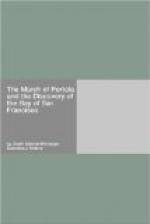was found to be Point Ano Nuevo. At 7 p. m. another
point came into view bearing north 1/4 northeast,
distant about twelve leagues, which was considered
to be Point Reyes. At 10 p. m., the wind being
northwest, the San Carlos steered west-southwest and
continued in that course until 8 a. m. of the 4th,
when the bearing was changed to the north-northeast.
At noon the sun’s altitude was taken and the
latitude was found to be 37deg. 11’, and longitude
17deg. 51’ W. of San Blas. At 6 p. m., August
4th, the southernmost Farallon of the Port of San
Francisco was seen to the northwest, distant about
eight leagues. The land to the north was Point
Reyes, bearing 4deg. W., distant about fourteen
leagues. At half past eleven, considering the
coast was near, the course was changed to the south-southwest,
until 3 a. m. of August 5th, when it was changed again
to the north-northeast 5deg. north to bring the ship
at sunrise to the point it was at sunset of the day
before. At 5 a. m. four of the Farallones of
San Francisco were seen to the north-northwest, distant
four leagues. Point Ano Nuevo was southeast 1/4
east from twelve to fourteen leagues and Point Almejas
northeast 4deg. east, distant three leagues.
At 8 a. m., being near land, commander Ayala lowered
the launch, and in it Pilot Canizares was sent with
ten men to search for an anchorage, while the San
Carlos continued along the coast. At 9 a. m. a
strong current was felt, which drove them to sea, but
at eleven it was observed that the vessel was nearing
the coast, which convinced the commander that it was
due to the tide, and this was confirmed by the soundings;
in entering the port, as on the first occasion, the
tide was going out, and on the second one the tide
was coming in. The altitude of the sun was taken
at noon of that day, with the utmost care, and the
latitude was found to be 37deg. 42’ and the longitude
17deg. 14’ W. of San Blas. At this time
Point Ano Nuevo was about fourteen leagues distant
to the southeast south; the Farallones to the northwest,
distant four leagues, and Point Reyes north 1/4 northeast,
distant four leagues. The wind was from the west.
At 4 p. m. the vessel was steered to the north-northeast,
and half an hour later soundings were taken and bottom
found at sixteen brazas[46] of mud and sand mixed,
and distant from the mouth about two leagues.
At 5 p. m. bottom was found at fifteen brazas, with
the same kind of bottom material. Sounding was
continued and the bottom was found to be as noted
in the large map. The current was so great at
the mouth of this port that at 8:30 p. m., with a strong
wind from the west-southwest with full sails, the
current allowed them to go not more than a mile and
a half per hour, which shows that the current must
go at least six miles at the middle of the channel.
The swiftness of the current, the fact that the launch
had not returned and that night was coming on, made
it necessary to seek for an anchorage; this was done
with great care and precaution; as the force of the




